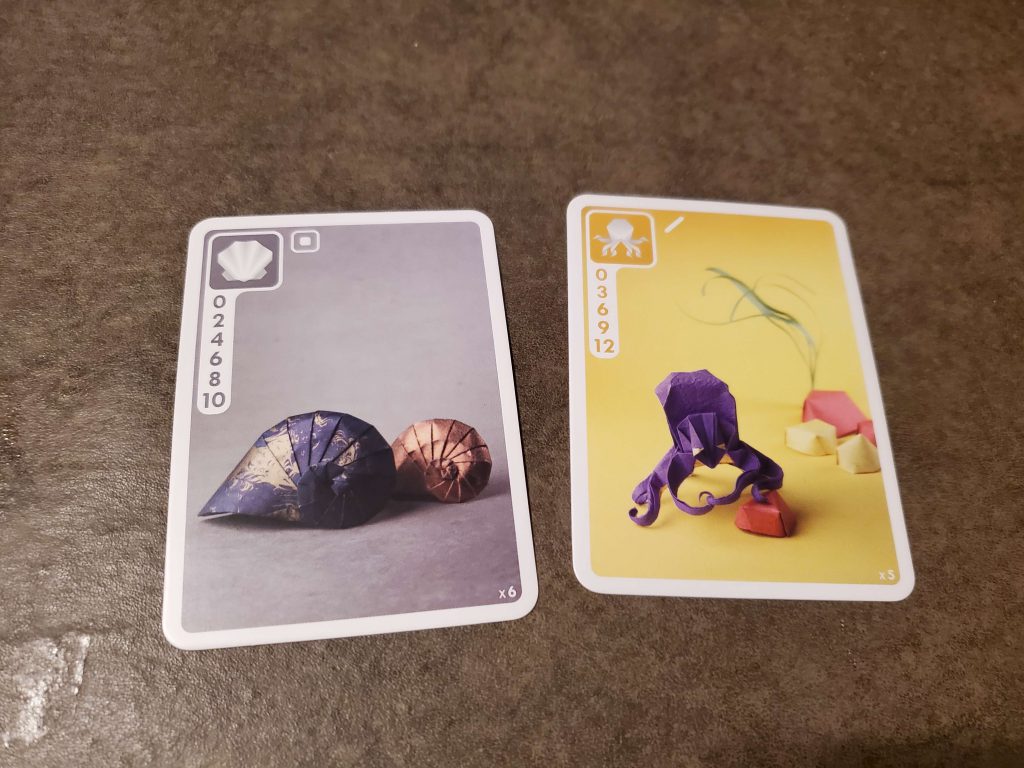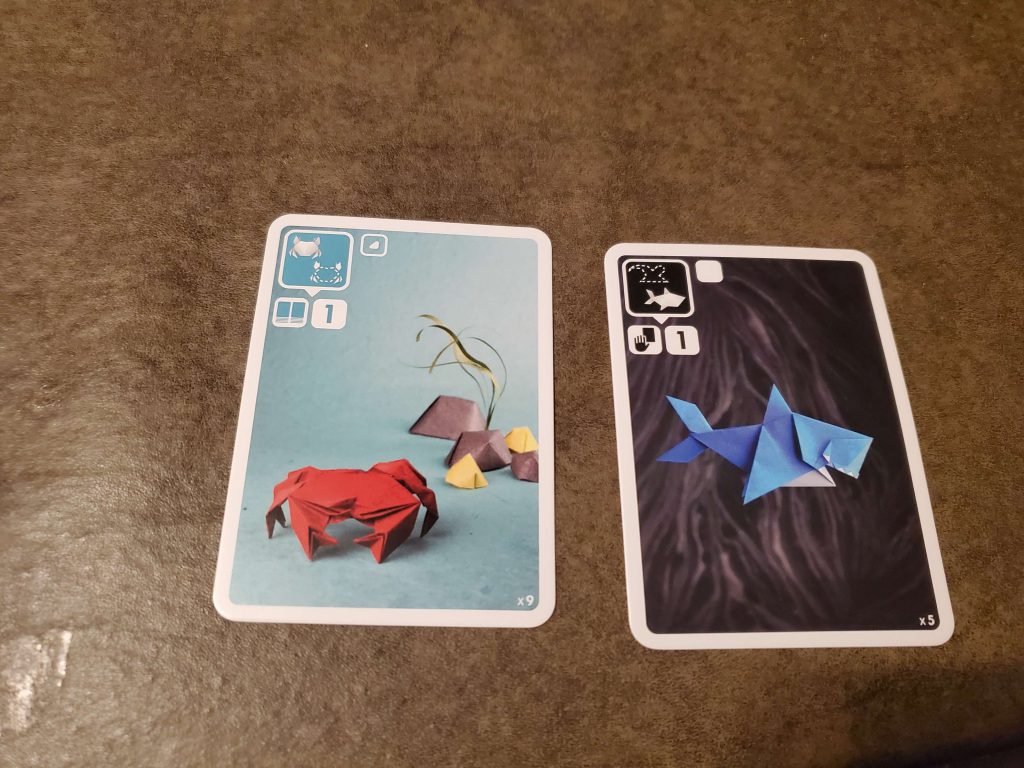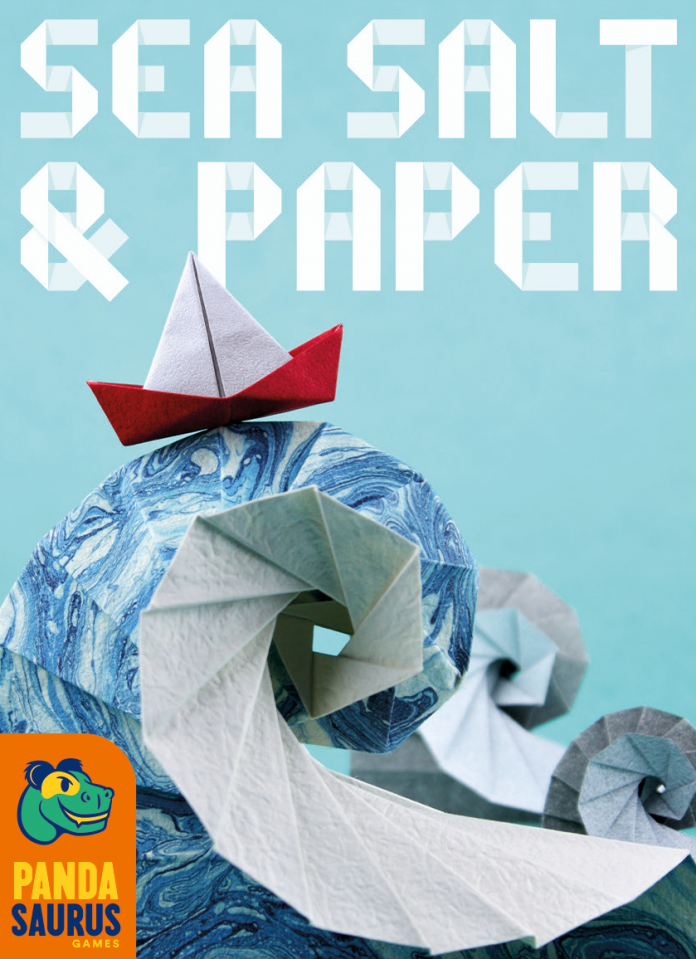When I sat down with Raina at the Pandasaurus Games Gen Con booth this summer, I was excited because I had heard they were the ones bringing the French card game “Sea Salt and Paper” to the US. I was interested in reviewing a few of their games, but as they were flying off the shelves that weekend (good for them!) I had to wait for Sea Salt to be mailed to me once convention season quieted down a bit. It arrived this fall and it is just beautiful! If you’ve read my other articles, you know I am a sucker for visually attractive games. Sea Salt does not disappoint!

The Japanese art of origami paper is delicate and beautiful and has touched many cultures. You can find it all over Japan, obviously, and it is a common craft in the United States. Some cultures like to fold money into decorative pieces to give as gifts. When my kid was growing up, a book series based on origami Star Wars characters became the hot items at the Scholastic Book Fair. So why not put origami into a card game? Designers Bruno Cathala and Théo Rivière hired the talents of Lucien Derainne & Pierre-Yves Gallard, who folded a host of sea life and nautical objects and put them on colorful backgrounds to photograph for Sea Salt and Paper. They used the Color ADD alphabet to help colorblind folks enjoy the game, too, so if you struggle with the colors given in the game, there’s a handy card showing all the symbols for each color to help you out. Our group had a great time looking over the cards and deciphering the signs after we exclaimed over the art. The penguins alone are amazing! I also found out that the legendary Japanese origami pro Tomoko Fuse did the spiral, navel, and solid seashells, which are in a class all of their own. I want prints of some of these shells for my house. But let’s get back to the actual game.

Sea Salt and Paper is a competitive hand management game with a set collection twist. You don’t need to collect sets to win, but it sure can help. You can also throw down pairs that give you bonus actions, collect cards by color to pick up a bonus multiplier at the end of the round, or push your luck by trying to collect all 4 mermaid cards by wheeling, dealing, and stealing your way to the top, because putting down all 4 mermaids wins the entire game. (This is maybe not the best strategy to push for, but if you reach it by luck and happenstance, RUN WITH IT!) I spent the first couple of games playing around with the strategies because I am terribly indecisive. Also, I wanted all the things.

Gameplay is fairly simple: players can either draw two cards from the top of the deck: one to keep and one to add to either of two discard piles on the table, or if they prefer, they can choose to pick up the top card of either discard rather than drawing blind from the deck. Players can get points for holding multiple shells or penguins or octopodes, or they can collect “duo cards”. For example: pairs of boats are only 1 point per pair, but allow you to take an extra turn, or a swimmer plus a shark, which allows you to steal a card from an opponent’s hand. Still other cards can give you bonuses for cards you’ve already put down: A lighthouse card scores you points per boat while a captain card will give you bonuses for the sailors you have in play. If you are clever/lucky enough, you can blast everybody at the table with sailors, a captain AND an anchor card. That was a powerful combination I didn’t see coming until my buddy put it down and swept the round. Finally, there are mermaid cards which give you point bonuses for having several cards of a given color. If you have more than one mermaid, you can score more than one color. If you have ALL the mermaids, congratulations, you have won the game, no more rounds needed, and we all hate you a little tiny bit because we must start the game over again to keep enjoying the pretty cards. Don’t worry, we’ll get over it. Probably. But since the Ultimate Mermaid Sweep is rare, let us look at the scoring details.

The end of the round is where my group had mixed feelings. The straightforward “You can declare STOP once you have reached 7 points” (or push your luck quietly and continue) seems to be the preferred option overall, partly because I am a terrible gambler and partly because I am not quite as sneaky as my opponents. The other option, “Last Chance”, allows each other player one more turn, which can cause the “Last Chance” caller to lose their windfall if they aren’t extremely sure of their position. If the player who declared “Last Chance” has the most points, they not only score their card points, but they also get a color bonus, scoring one additional point for each card in their biggest color pile. In this case, each opponent only scores the color bonus, with zero points for their pairs, sets, mermaids, or anything else. If the gambler who called “Last Chance” does NOT have the most points, that player only scores their color bonus while everyone else gets to score their normal card points. I personally don’t like sticking my neck out like that, but if I saw it work for others, I may try it occasionally. During the series of games we played before this article, every “Last Chance” came very close points-wise, but ultimately failed. I don’t know if that is just because of the players we had or if this is a common occurrence for others. It just seems better to end the round rather than get pushed from the top of the mountain. Your experience may vary, and I encourage you to play with the options.
At this point if nobody has collected all 4 mermaids and swept the game from everybody else, the rounds will continue until a points goal is reached (determined by the number of players). This can take 15-30 minutes once you have gotten the stride of the game and you’re not constantly checking the guide for symbols and scoring and what each Duo allows you to do.
Sea Salt and Paper is very portable and is a great backpack stash for travel, or even in your airline carry-on. It can charm non-gamers and seen-it-all gamers alike. It is quick enough for a multiple game gathering of friends or a quick icebreaker before an event. It’s family friendly for most elementary school kids and runs 2-4 players. If you like games such as Love Letter, Sushi Go, and Fluxx, I would strongly recommend that you pick up Sea Salt and Paper and give it a try. There’s even an expansion coming out in January 2024, called EXTRA SALT!



You must be logged in to post a comment.